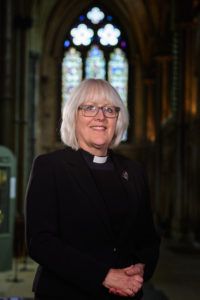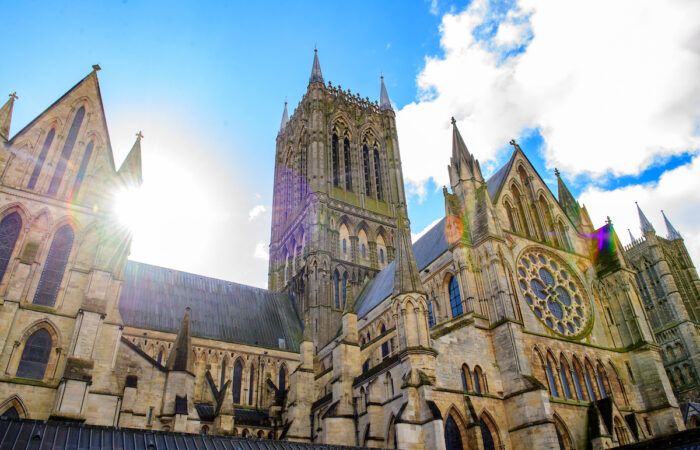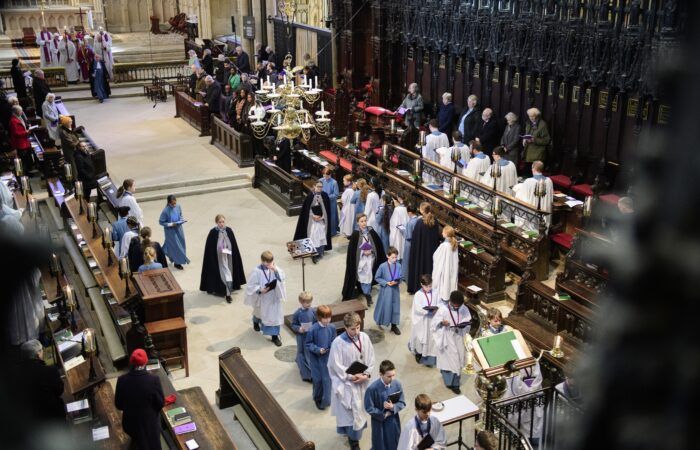The Very Reverend Christine Wilson, Dean of Lincoln
Readings: Ezekiel 37: 1-14, Psalm 130 & John11: 1-45

If ever there was a moment that reminded me of the valley of the dry bones, then that scene comes close. Human Spirits that have been crushed of all hope and beauty are suddenly brought to life as the music nurtures their barren souls.
When Ezekiel spoke his vision he was speaking to a nation that was desolate: To the disheartened people of Israel, in their captivity in Babylon. The valley of the dry bones is a vision where the prophet calls upon the “Breath” or “Spirit” of God to bring joy and hope back into their lives. It is a story, quite literally, full of inspiration, particularly in times when on the face of things all hope seems to have vanished. A story that reminds us that even in those moments when we feel overwhelmed or dispirited and all our positive resources have come to an end, we have a God who can breathe life into that which appears dead.
Ezekiel expresses a faith that declares that no matter how bleak the situation may seem, new life and a new future can be possible. This theme of death as the gateway to life runs through today’s readings and as we move on in our Journey through Lent, drawing closer to Christ’s own Passion and Death we are invited to consider death and resurrection in our own lives and the way that God kindles hope for us through his Son.
You only have to look in the parks and gardens across the city to be reminded at this time of year of this miraculous pattern of death and renewal in the awakening of the earth from its winter sleep. In the bright green buds and the daffodils which herald the new life of Spring and here in our Gospel reading the account of the raising of Lazarus, invites us to reflect on what is being communicated. Lazarus becomes a part of the cycle of death-to-life, called from the tomb into the world of the living.
For the early Christian Church, the story of Lazarus answered their particular questions about the death of believers. In his gospel John taught that the eternal life that Jesus gives his followers does not abolish death but rather transcends it. What matters is belief in the power Christ to transform our lives. But for us there is also a lesson about living that transcendent life now in the present. Jesus says to Martha that believing in him is what life is: Which suggests that eternal life can begin now – we don’t have to wait until we die.
We learn that belief in the power of Christ to bring about hope and resurrection in our lives can allow us to transcend the struggles. It might not take them away, but we will be empowered to overcome them. Faith enables us to see beyond all earthly limitations and the breath of hope allows unimaginable things can happen.
Ezekiel declared this when he spoke God’s words to Israel: “O my people. I will put my spirit within you, and you shall live.”
The Lazarus story of being called out of the tomb into the world of the living is another image depicted in the film the Shawshank Redemption. After over twenty years of hope and determination Andy Dufre, who has been incarcerated for a crime he didn’t commit, has managed to patiently chip away a tunnel and he makes his escape. The final exodus from captivity is via the filthy prison sewer. As he emerges from this dark and stinking tomb into the river beyond the prison grounds, we experience his exhilaration in a scene that resembles an act of worship. As he celebrates the act of his deliverance, all that has gone before is in the past and a glorious hope-filled future stretches out before him. It reminds me of that passage from Paul: “I consider the sufferings of this present time, to be nothing compared with the glory that is to be revealed.” For Andy Dufre it is a resurrection moment. And his deliverance brings hope to all the other prisoners.
In Ezekiel’s vision the people of Israel appeared to be lifeless, dried up and parched. For many years they had been exiled in a foreign land. They were full of questions, full of bewilderment. As far as they were concerned all hope had vanished. Could God possibly effect a rescue even from this scene of desolation? And likewise Martha, looks in disbelief at Jesus. How can he even speak of reviving Lazarus? The smell of death already fills the air and hope has long been abandoned.
Jesus said to her, ‘Did I not tell you that if you believed, you would see the glory of God?’
As Christians we are called to testify to the hope we have within us: To proclaim the faith that allows us to believe that no place is to dark or too desperate for God to effect a rescue. Jesus said to Martha, ‘I am the resurrection and the life. Those who believe in me, even though they die, will live, and everyone who lives and believes in me will never die.
The crucial question that Jesus poses to Martha is also addressed to each one of us.
Do you believe this?’ Do you believe that Christ can breathe his spirit of eternal life into parched souls? Do you believe that Christ can rescue us from all that deadens our lives and stifles hope? Can these dry bones can live? That God’s purposes cannot be frustrated by those who seek to crush hope and diminish joy?
Martha, through the gift of faith was able to say: ‘Yes, Lord, I believe”.
Renewal begins with us as by God’s grace we enact hope, as we bring about resurrection moments of joy and renewal, as we seek to demonstrate God’s loving embrace of us all and as we draw upon the extraordinary God-given human capacity to resist defeat and choose life.
In these uncertain times let us reach out and enact the hope in our hearts. Amen.

